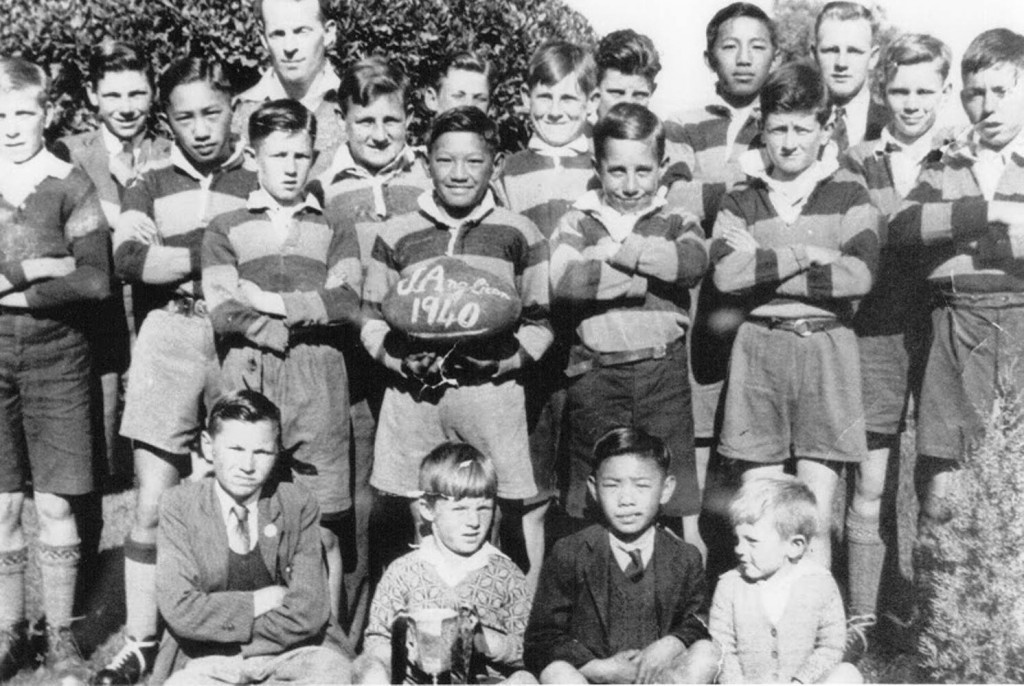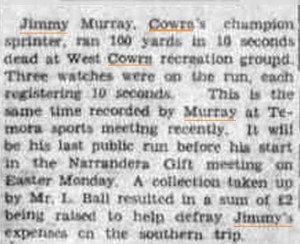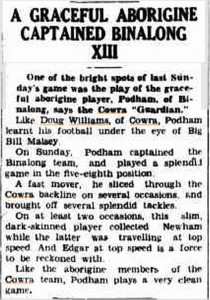Maher Cup Country was and is a pretty culturally homogenous place, but there was always enough of a mix to make it interesting.
An hour before the first ever Maher Cup match Otto (Boydie) Beegling, the butcher’s son, and a highly respected young man from Tumut, warmed up the crowd when he took on a Adelong rival in a challenge footrace at the oval. Eric Weissel, Bill Lesberg, Eric Kuhn, Charlie Schwartzel, Henry, Les and Tony Gelfius, Joe Steinke, Paul Butz, Len Koch and a 100 or more others with German names helped bring home the Cup to excited communities.

The great Cootamundra Maher Cup Team of 1923 – undefeated at the end of the year after 18 challenges. Under the rules the Cup then belonged to them – but they put it back into play. Players pictured include Eric Weissel (above Cup on right), Bill Lesberg (back row 4th from left) and Charlie Schwartzel (back 6th from left).
There are anecdotal reports that opposing fans would shout ‘Hun, Hun, Hun….’ in the early years after the Great War when Lesberg, one of the greatest kickers the game has ever seen, prepared to inevitably add some more points for Cootamundra. There is however much more evidence of acceptance, inter-marriage, respect and promotion to leadership roles within the community. The Freudensteins of Young and Grenfell being prime examples. Ernie Gerstenberg was in the 1930s handed the no mean task of sorting Group 9 and Maher Cup disputes.
While Weissel and Lesberg had railway connections, most Germans in the Riverina were farmers, pious, hard-working families who had worked their way across from South Australia. Folks with British heritage tend to consider the grazing of stock to be somehow of superior social status than the growing of grain. However the Germans were proud dirt farmers, skilled soil conservators with a religious commitment to improving and protecting the land for future generations.
In the stories of his people penned by Eric Otto Schlunke of Reefton there was little interest in the frivolities of football. Even so two of his nephews represented Barmedman in the Maher Cup.
At Trungley Hall near Temora German Lutheran farmers had taken up closer settlement en masse. Between 1914 and 1918 they kept a low profile. Many of their sons enlisted. They later had little trouble blending. Most eventually married ‘out’ and quietly merged into the community.
Bill Lesberg’s brother was killed at the Somme. Eric Weissel had a heritage that valued the church and placed devotion through choral singing at its heart. ‘Ec’ enjoyed nothing more when not playing football than to sing with superb voice in the Church of England choir.
– – – – –
Travelling ‘Syrian’ hawkers, originating from present day Lebanon, were prominent on the goldfields and rural communities before the towns developed permanence and when the journey from farm to shop was arduous. They eventually settled and set up stores and businesses.
Cootamundra had a considerable community with names such as Deep, Matha, Batros and Sissian. Jack Sissian played Maher Cup and possibly also the Batros Trophy which was put into play one some of the family set up business in West Wyalong. The Moses family were represented at Tumut, Gundagai and Harden where they had thriving businesses. Lou Moses, the Harden club secretary and big football punter featured the Maher Cup in his advertisements. The Solahs provided footballers for both Harden and Barmedman. The Bounaders at Gundagai made and screened movies of local football in their cinema. Later when Norm Bounader had a cafe his car was at the disposal of footballers travelling away.
– – – –
Young, as Lambing Flat, is famous for promoting Australia’s turn away from racial variety. While most Chinese miners went back home, some ‘celestials’ survived the white Australia policy to become successful merchants and market gardeners. At Cowra Harry Chong Sun, whose family grew prosperous growing vegetables along the Lachlan, was a regular for the Maher Cup team from 1945-1947. Allen Foo from Tallimba played for West Wyalong and Alan Fong for Barmedman and West Wyalong. Both had Chinese-born grandfathers. Alan Fong changed his name to Alan Clarke. The Doon boys at Tumut were outstanding examples of integration. The Doons even won the Melbourne Cup.
– – – –
Greeks worked themselves and their families hard in cafes which promised the locals a touch of American culture – The Niagara, The Californian, The Monterey and The Hollywood. Others like the Acropolis and Olympic revealed their origins. Greek-Australian bonds forged in World War II were celebrated in The Victory and The Allies. Some cafes seemed to be named after the chocolate boxes they sold – The White Rose and The Garden of Roses. While all towns and most villages in the Riverina had Greek cafés, many also possessed Greek-run grocery stores, fruit & veg. shops and picture theatres.
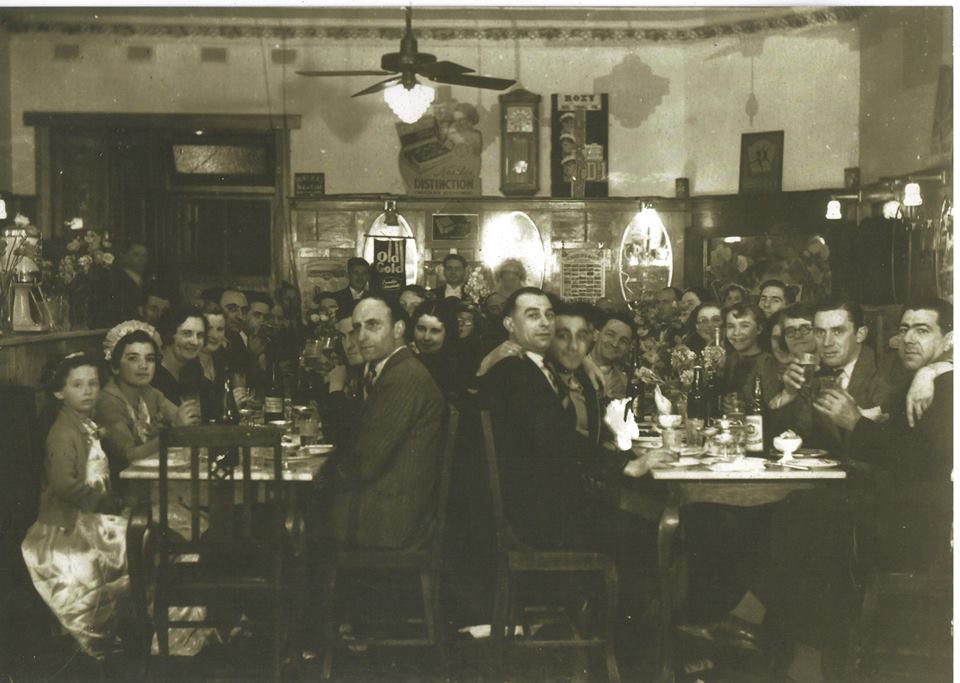
A Greek families gathering at the Silver Star Cafe, Cootamundra – 1930s. Source: Deidre Winters on Cootamundra Remembers.
Although always vulnerable to racist abusive from hungry drunks, the cafe owners and the football clubs were natural allies. The fans (particularly the woman and children) crowded into booths before and after matches.
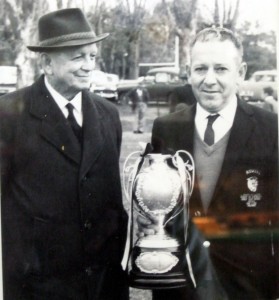
Vic Castrissian holding the Maher Cup, with local member Billy Sheahan. Source: Photo. on wall of the Niagara Cafe
At Gundagai the Castrission brothers were sporting enthusiasts, with Vic becoming club president. At West Wyalong the Rugby League had no supporter more loyal than Georgie Minos who distributed oranges at half-time.
And they sponsored many football cups. There were Garden of Roses, White Rose, Stathis, Paragon and many other cups that came and went.
Although Peter Calligeros of West Wyalong, Con Condos at Cowra and John Michael at Temora, took to the field in the Maher Cup, few children of the cafe owners played football. One suspects they wouldn’t have had the time. Like most migrants their parents ensured any spare time was to be invested in the pursuit of educational excellence and the escape from economic insecurity.
– – – –
Maher Cup country is Wiradjuri country but by 1920 most Aboriginal people had been herded into camps. Of these only Erambie at Cowra, and Brungle (half-way between Gundagai and Tumut) were located within the Group 9 drawing area. Other ‘missions’ were created at Yass, Darlington Point, Condobolin and near Lake Cargelligo.
At both Erambie and Brungle ‘Allblack’ teams were established in the 1920s and, particularly at Cowra, the success of the team became of source of community pride. While ‘Digger Davis’ and Joe Nettup from Brungle were identified in the 1920s as brilliant footballers, they never made it to Maher Cup teams. The first mention of an Aboriginal connection to the Cup was in 1927 – when the popular Brungle gum leaf band entertained revellers in the streets of Gundagai when ‘Chook’ Fraser’s Bidgee Boys arrived home victorious.
The reasons for non appearance in Maher Cup matches is more complicated than the undeniable racism. Football didn’t pay much if anything. Indigenous athletes were usually focused on making some income from their talents, so more professionalised sports such foot-racing and boxing were often the main game.
The first Indigenous player who just couldn’t be ignored was speedster Jimmy Murray of Cowra, who first played in 1938. In 1940 reviewing Cowra’s prospects a 2LF publication stated ‘…if Murray stays, which is problematical, they will be a stiff hurdle for any aspiring team’. Outspoken at the local practice of his people being ushered through a side gate at the Cowra Showground, Murray eventually left town, enjoying a highly successful career playing Australian Rules, running and boxing in Victoria.
The main gates opened at Cowra soon after with locals Arch ‘Bricky’ Bamblett, Harold ‘Ado’ Carberry, Viney Murray, Doug Williams and Dick and Len McGuinness participating in the Maher Cup matches in the 1940s. Dick McGuinness in particular was often considered to be brilliant.
One of the most enigmatic Koorie characters in Maher Cup football was Henry (Harry) Podham, the captain-coach of Binalong – a village that only made one single challenge, in 1946, against a champion Cowra side containing Dick McGuinness and Doug Williams. Podham had been a prominent player at Yass for many years, and was involved in establishing the Redfern All Blacks, as well as playing some matches with South Sydney.
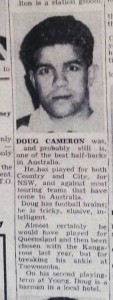 By the 1950s Aboriginal players were becoming more familiar to fans – Vince Bulger at Gundagai, Bill Mumbler at Harden and Gundagai and Bob Glanville at Cootamundra. Arguably the biggest Indigenous star of the Maher Cup era was Young’s half-back Doug Cameron. He came down from Queensland via Chippendale and played Maher Cup from 1956-1960. The press never referenced his indigenous heritage. He later became a successful hotelier in Tumut.
By the 1950s Aboriginal players were becoming more familiar to fans – Vince Bulger at Gundagai, Bill Mumbler at Harden and Gundagai and Bob Glanville at Cootamundra. Arguably the biggest Indigenous star of the Maher Cup era was Young’s half-back Doug Cameron. He came down from Queensland via Chippendale and played Maher Cup from 1956-1960. The press never referenced his indigenous heritage. He later became a successful hotelier in Tumut.
– – – –
The other minority group in Maher Cup Country – the biggest one – are the Irish Catholics. However their influence from Ted Maher onwards has been so profound that they can not really be considered a minority. The majority of players were probably Catholics – as were so many of the characters that shaped its drama. However that’s another story.
References, other than those linked above:
- Bamblett, L. (2013) ‘The famous Erambie Allblacks’ in Our stories are our survival.
- Jupp, J. (ed). (1988) The Australian People


